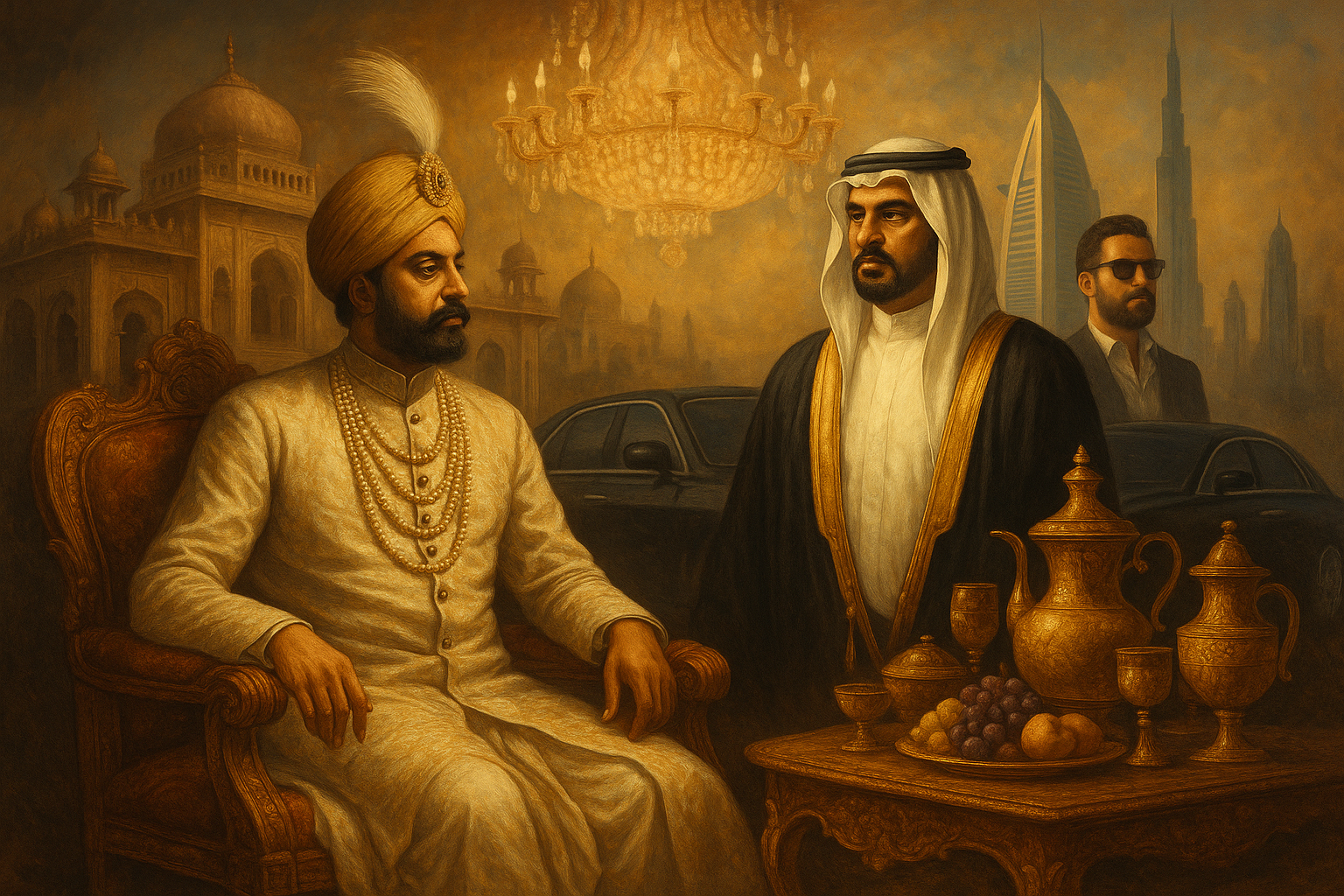Executive Summary
This report investigates how elite decadence and conspicuous consumption have historically precipitated societal decline in the Indian Subcontinent and the broader Muslim world, from the 17th century through European colonisation and into the post-colonial era. It examines the opulence of the Nawabs of Awadh and other regional rulers, explores analogous patterns in Qajar Iran, Ottoman Turkey, and Khedival Egypt, and extends the analysis to contemporary ultra-wealthy elites in the Gulf and South Asia. The key thesis is that unchecked elite extravagance fosters social inequality, weakens state institutions, and invites political collapse or foreign domination.
Part I: Decadence Under Empire – 1700 to 1950
The Nawabs of Awadh: Grandeur Without Governance
The Nawabs of Awadh, particularly from the mid-18th century onward, became emblems of indulgence. Nawab Wajid Ali Shah maintained a court of dancers, poets, and hundreds of concubines while neglecting military and administrative functions. His extravagant spending, including the construction of pleasure gardens and palaces, led to public debt and widespread resentment. When the British annexed Awadh in 1856, citing misrule, the Nawab surrendered without resistance. His court’s decadence had hollowed out the state’s institutional backbone.

The Junagadh Dog Wedding: Absurd Excess
In 1922, the Nawab of Junagadh famously hosted a multi-day wedding for his pet dogs, complete with gold-plated jewelry, feasts, and processions. This event, costing millions in today’s terms, came at a time when ordinary Indians were enduring poverty under colonial rule.
Ottoman Turkey and Qajar Iran: Palaces Over Public Welfare
Sultan Abdulmecid’s Dolmabahçe Palace, built with 35 tons of gold, pushed the Ottoman Empire into insolvency. Similarly, Iran’s Qajar Shahs secured European loans to fund European tours and luxury projects, effectively mortgaging national sovereignty. In both cases, elite lifestyles overrode fiscal discipline and made these nations ripe for financial and political control by European powers.

Egypt: Khedive Ismail’s European Aspirations
Khedive Ismail built Parisian-style boulevards in Cairo and hosted the Suez Canal opening with opulence that bankrupted Egypt. This led to the sale of the Suez shares to Britain and, ultimately, to British military occupation in 1882.
Part II: Post-Colonial Gilded Age – 1950 to 2025
The Sultan of Brunei: Wealth Beyond Measure
Sultan Hassanal Bolkiah’s net worth exceeds $30 billion. His palace has over 1,700 rooms; he owns more than 7,000 luxury cars and a gold-plated Boeing 747. The Sultan’s decadence mirrors that of fallen monarchs of the past, raising questions about sustainability.

GCC Royalty: The New Nawabs
Saudi and Emirati royals own fleets of superyachts, purchase $400 million artworks, and build palaces in Europe. Lavish weddings (such as Sheikh Zayed’s $100M celebration) echo the royal durbars of old. Meanwhile, millions of South Asian and African workers live under poor conditions in the same countries.
Antilia: Mumbai’s Sky Palace
Mukesh Ambani’s 27-storey mansion, Antilia, cost over $1 billion and employs 600 full-time staff. His daughter’s wedding in 2018 featured performances by Beyoncé and spanned multiple international venues, costing more than $100 million.

Analysis: Decadence and Societal Decline
Throughout history, excessive luxury by a ruling elite has eroded the legitimacy of states:
- Economic Drain: Huge sums are diverted from development to sustain elite lifestyles.
- Social Stratification: Lavish consumption in the face of poverty leads to unrest.
- Loss of Sovereignty: Debt or foreign dependency often follows.
- Collapse or Conquest: As seen in Awadh, Egypt, Iran, and now in the fragility of certain Gulf regimes.
Modern ultra-wealth also isolates elites from the lived reality of the majority. The widespread use of private jets, global real estate, and hyper-exclusive events builds a class beyond reproach or empathy. In societies like India and the GCC, these patterns resemble late-stage empires on the brink of overreach.
Conclusion: Lessons from the Past
History offers a recurring lesson: when a society’s elite chooses luxury over legacy, pleasure over public service, and status over statecraft, decline follows. The fall of the Nawabs and Sultans was not inevitable, but it was accelerated by their decadence. Today’s ultra-rich elites face a similar crossroad. Will they reinvest in society and avoid the mistakes of history? Or will they become 21st-century cautionary tales?



